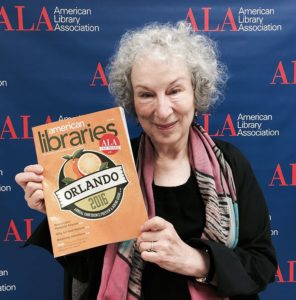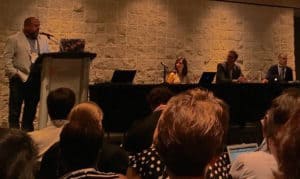
Having a functioning makerspace depends more on your people and your relationships in the community than on your technology. That’s the message a group of experienced makers gave to attendees at a packed session on Friday.
Rebekah Willett, assistant professor of library and information studies at University of Wisconsin-Madison, moderated this session, in which participants rotated through three 30-minute brainstorming sessions led by experienced makerspace facilitators in six different specialties:
- Honore Bray, director, Missoula (Mont.) Public Library: “STEM and Learning Styles”
- Michael Spelman, supervising librarian, Madison Public Library: “Advocacy for Making”
- Rebecca Millerjohn, Bubbler project assistant, “Madison Public Library: Making in the Community”
- Jesse Vieau, teen librarian, Madison Public Library: “Learning in Purposeful Programs”
- Trent Miller, Bubbler manager, Madison Public Library: “Artist-in-Residency Programs”
- Heather Moorefield-Lang, assistant professor, School of Library and Information Science, University of South Carolina: “Makerspaces and Training”
The brainstorming breakouts were observed by three roving “discussants,” who offered their summaries of the activity in the last 30 minutes of the session:
- Tim Carrigan, senior library program officer at the Institute of Museum and Library Services
- Michele Gorman, deputy director of Houston Public Library
- Mary Kate Quillivan, studio services manager at Richland Library (Columbia, S.C.)
Although the six breakout topics were unique, several themes popped up repeatedly.
Invest in people over equipment. Millerjohn noted that the Bubbler (Madison’s makerspace) invests in people in the community instead of equipment—they can run several workshops for the price of one 3D printer. Others echoed this sentiment. Creating a well-run makerspace was more about creating a culture of problem-solving and trying new things, not in having the latest gadgets.
Moorefield-Lang pointed out that 3D printers are cool but are still slow and expensive, and many libraries are choosing to do more, smaller projects with that money. Her research has shown a trend toward more thematic makerspaces focusing on topics like fashion, gardening, or engineering. The maker movement started wide and is now narrowing down to what libraries and communities really need and want.
Think creatively about resources. Librarians are concerned about financing, but also about resources generally—such as equipment, space, and people. Miller explained that the Bubbler’s first summer of programming was funded by selling some donated Beanie Babies, which raised $274. “As long as you have Beanie Babies, you can do this,” he cracked.
Vieau, who creates teen programming, has learned to reach out to groups that are already working with teenagers, such as social workers and youth groups, rather than trying to market programs from scratch.
Gorman said the key to success was not about funding, but about relationships. All the money in the world won’t keep your program from failing if you have no community support.
Instead of focusing on everything your library lacks, think about what resources you do have for a potential community partner. Offer your library as safe, free community space to groups, startups, clubs, or artists. For example, Miller warns against paying artists in “exposure”—a better option if you don’t have the funds is to offer connections with the community in a new way or offering space for a project or exhibit.
Find expertise outside the library. Accept that the expertise you need to run a maker program people want—anything from circuitry to cheesemaking—might be outside the library. An added bonus: When you build a community of experts, you’re not confined to what your staff knows.
However, you will need to find makers and instructors who are a good fit for your library rather than taking anyone who’s willing to teach a workshop. That artist or maker might have a lot of free time and energy, but can your space handle screen-printing equipment or oil-painting fumes? Does that instructor have experience working with kids? Having a system in place for choosing the artists and instructors you work with will make the process easier for your staff.


